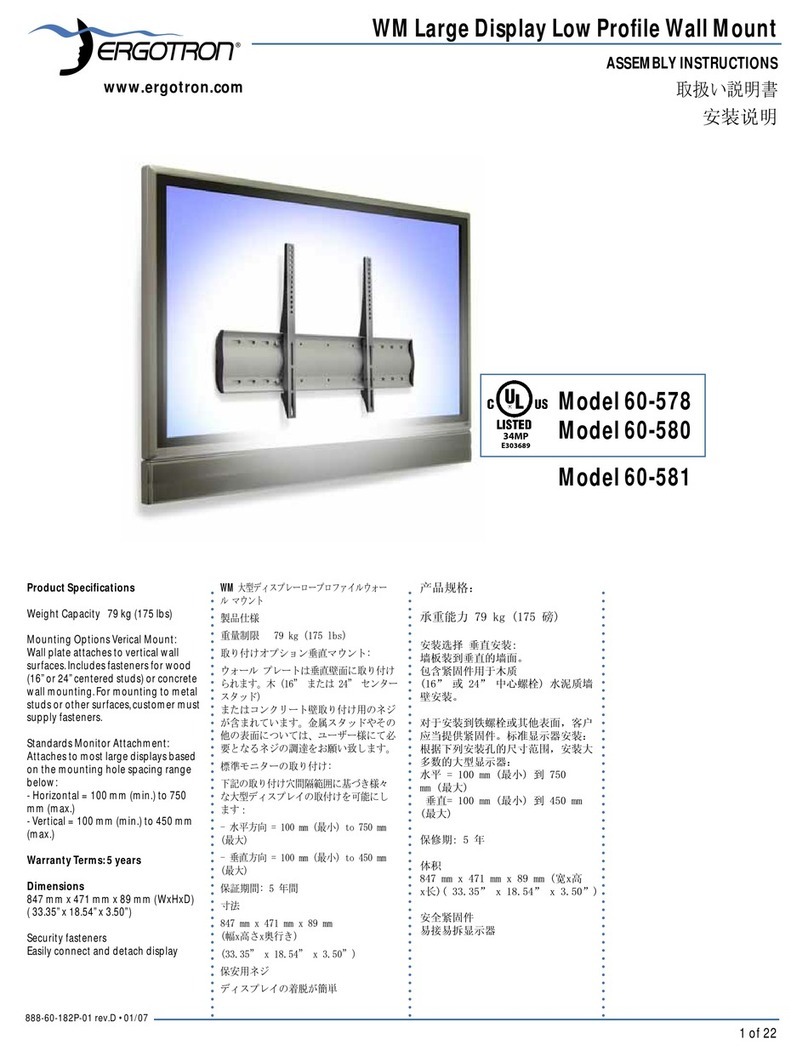
888-45-045-01 rev.C • 11/05
6 of 6
vv
MM
² ²
vv
MM
v
MM
* For details on the scientific basis for this
remarkable product or to utilize the stand
for the 5% Female to 95% Male Range of
Population, check out the white paper
entitled "Design of an Ergonomically
Correct Desk Stand for Flat Panel Monitors"
on our web site, www.ergotron.com.
9Ergonomic Ground Rules
© 2005 Ergotron, Inc. All rights reserved.
Patents Pending and Patented U.S. & Foreign. Ergotron is a registered
trademark of Ergotron, Inc. Reproduction of this material in whole or part
for any purpose other than that authorized by Ergotron, Inc. is prohibited.
Warranty
The recommended mounting heights, the range of adjustability required to provide comfortable
use by a range of operators, and the forces required for making adjustments to the display that are
shown in this paper are based upon the following ergonomic ground rules gleaned from the available
scientific literature and published standards on this subject. *
Display Screen Height
Recommended display height: set top of the display screen at or slightly below (approximately 25
mm [1”]) the eye height of the user when the user is sitting or standing in a comfortable, relaxed posi-
tion. This will place the center of the screen at the ideal 15° to 20° below eye height for most desktop
displays. The screen height should be easily adjustable to accommodate gender height differences
and the operator’s personal preferences throughout the day. Further, the viewing height should allow
the operator to view the display screen within an orthopedically correct “viewing cone” to minimize
musculoskeletal stress disorders (MSD’s).
Display Screen Tilt
Tilt Display upward with the bottom of the screen tilted toward the operator to provide optimum
viewing. This position provides a consistent focal length when scanning from the top of the screen
to the bottom. A tilt range of -5° to +30° is usually adequate depending upon the size of the display.
Note: When upward tilt is used, special care must be taken to minimize screen glare.
Screen Distance from Operator
Normally the display screen should be placed as far away as possible from the operator, consistent
with the ability to read the information presented on the screen. (The normal focal length for most
people exceeds 762 mm (30”) or greater, however, from a practical standpoint a recommended view-
ing distance from 457 mm (18”) to 710 mm (28”) is mentioned by several ergonomic standards.) A
good rule of thumb for most installations is that the display screen should be placed at arms length,
with the ability to move the display back and forth to suit individual needs being the ideal. Vertical
adjustments should not result in a change in focal length.
Screen Adjustment Forces
The moving force to make any adjustment to the display, vertical position, tilt, pan or portrait/land-
scape rotation should not exceed 2.32 kg (5.1 lbs).
Keyboard Height/Positioning
Keyboards should be placed at a height that allows the operator to operate the keyboard with the forearms level and hands sloping slightly downward. A
negatively tilting keyboard, allowing the operator to “keep the wrinkles out of the top of the wrists” is ideal. Fore and aft positioning of the keyboard should be
consistent with allowing the hands to move easily over the keyboard with forearms level and elbows at the sides, maintaining a 90° - 120° angle between upper
and lower arms. If the top of the display screen is
set 25 mm (1”) below the operator’s eye height
asrecommended, then thecentral row ofthe key-
board should be positioned 50.8 cm (20”) below
the top of the display screen for the average
range of users.















































